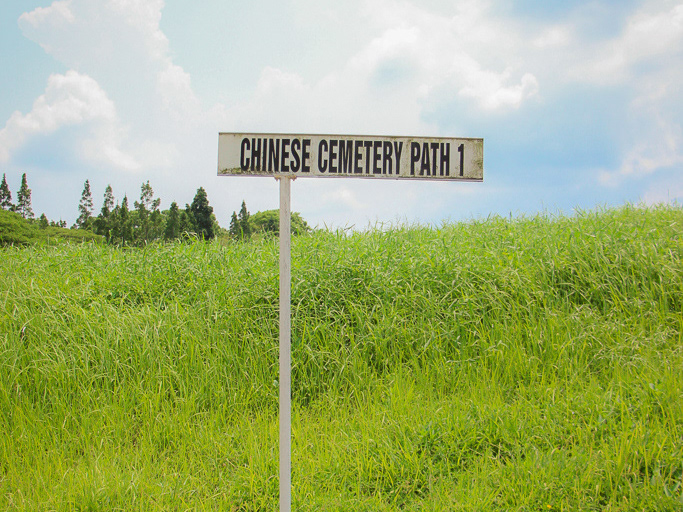Liu Kang’s aesthetics embody the vibrant fecundity characteristic of Nanyang art. His is a world of saturated shades, the rustic radiance of life in the tropics rendered in a masterful blend of Eastern and Western artistic practices. Significantly, however, Liu’s idyllic realm is predominantly populated by women, who often appear as bare-breasted, willing objects of the artist’s watchful gaze.
To be female in Liu’s works is to be perfectly submissive to a powerful, privileged man. Liu’s position as a Chinese artist painting indigenous Balinese women further introduces an exoticization performed along racial lines.[1] That these facts undergird a substantial part of Liu’s practice is unsettling and deeply uncomfortable to many modern viewers. At the same time, the influence Liu Kang has had on the trajectory of Singaporean and Southeast Asian art is undeniable. Liu’s distinct visual vocabulary in depicting a regional landscape was highly compelling, effective in presenting a national and regional narrative decoupled from colonialism.[2]
We cannot simply dismiss Liu’s paintings as misogynistic fodder of an outmoded age. Yet, to blindly laud Liu as a pioneer Singaporean artist is potentially dangerous. It ignores the fact that many of Liu’s subjects did not have the social autonomy to explicitly reject being photographed or painted,[3] or that some of Liu’s compositions voyeuristically detail local practices typically kept private or discreet.[4] We must confront the issue of female submission in Liu Kang’s paintings. The question that remains is how?
Liu Kang. Bathers. 1997. Oil on canvas, 118 x 169 cm. Collection of National Gallery Singapore.
Put forth by film theorist Laura Mulvey in 1975, the theory of the male gaze presents an active male protagonist imposing his phantasies onto a female figure.[5] She is a representative spectacle for his emotions and ideals, with no intrinsic significance beyond what is conferred onto her. This presentation of the woman in cinema presupposes a male audience that relates to the protagonist, who transfers his power in controlling cinematic events onto the voyeuristic moviegoer. It is thus the male spectator who enjoys the omnipotent pleasure derived from looking erotically at the on-screen female object.[6] Such a theory is applied more directly to European fine art by critic John Berger, who states: “Men act and women appear.”[7] For Berger, such a dynamic––reflected time and time again in art from the Middle Ages on––manifests not just between men and women but in the relation of women to themselves. The woman comes to see herself through the lens of a man, turning herself into an object to be enjoyed by men.[8] Her predicament is socially imposed, but also self-perpetuated and thus difficult to escape.
A stamp featuring ‘Siesta in Bali, 1957’ by Liu Kang. 2004. Paper, 4.2 x 2.8 cm. Collection of National Museum of Singapore. Courtesy of National Museum of Singapore, National Heritage Board. Gift of Singapore Post Limited.
We can see how Liu positions women as objects of the male gaze in his paintings. Liu’s anonymous Balinese woman is one styled with eyes downcast, unable to confront the viewer as an equal. Her turned-away gaze affects subdued humility and submission.[9] It invites the male viewer to look at her body––indeed, in Liu’s work, the woman’s chest is often deliberately positioned in a direct frontal view, pertly upright and sometimes even defying gravity––without fear that the woman will assert herself to force recognition of their common humanity. Liu’s objectified woman poses no threat to male domination, providing pleasure both as erotic object and in affirming the man’s superior status. Such a woman confirms feminist philosopher Simone de Beauvoir’s assessment of woman as Other: “She is the ideal intermediary between nature that is foreign to man and the peer who is too identical to him. She pits neither the hostile silence of nature nor the hard demand of a reciprocal recognition against him; by a unique privilege she is a consciousness, and yet it seems possible to possess her in the flesh.”[10]
Liu Kang. Artist and Model. 1954. Oil on canvas, 84 x 124 cm. Collection of National Gallery Singapore.
By contrast, Liu, as the artist, is the ultimate authority over his subject and his painting. This desire to privilege the artist as centre can be observed through Liu’s inclination towards portraying the practicing artist as a subject in his works.[11] Such self-conscious depictions not only position Liu-as-artist as the preeminent figure controlling the composition, but enact the power of the male gaze within the pictorial space itself.[12] Male domination, intersecting with the creative, positive power of the artist, is directly amplified. The necessary corollary is that female submission takes on a further dimension of negativity and unnaturalness, even as women’s submission has historically been an expected norm.[13] Beauvoir scholar Manon Garcia observes that this orientation of submission in opposition to humanity’s natural right to freedom has persisted throughout the history of philosophy.[14] However, such a belief condemns women to moral inferiority while ignoring the fact that female submission is often a direct result of the social situation a women has in her society, which prevents her from exerting her freedom in the same way a man can.[15]
Liu’s depictions of Balinese women are defined primarily by the male presence in the painting, alienated from their personal autonomy. Read through Garcia’s analysis of Beauvoir, such objectification on canvas makes submission appear as an objective condition of the Balinese women, rather than the result of men’s domination.[16] In reality, their submission is one enforced onto them by social norms. Further, for a woman living in a tourism-dependent community, both the social and monetary cost of freedom from submission is incredibly high.[17] Liu’s paintings crystallise this appearance of objectivity without capturing the true complexities of female submission. To view his work without this understanding is to continue to accept submission as an unchallengeable truth of the female experience. We perpetuate an art history that seems almost to celebrate female submission as something to be gawked at on gallery walls.
It is precisely that Liu’s oeuvre has great cultural significance in our national and regional contexts means that we must acknowledge its great capacity for harm. This harm is not explicit. Rather, Liu’s paintings work within a larger patriarchal framework to present and entrench female submission as women’s natural, inevitable fate. Yet, this is not the reality of women’s situation. In looking at Liu Kang’s works, we must critically engage with these power dynamics embedded within his canvases. Such analysis allows us to both appreciate the mastery of Liu’s practice while contextualising its inherent injustices, nuancing our understanding of the idyllic beauty captured in his works. As Mulvey put forth as her ultimate purpose in conceptualising the male gaze in the first place: “It is said that analysing pleasure, or beauty, destroys it.”[18]
Endnotes:
[1] Wang Ruobing, “The Quest for a Regional Culture: The Artistic Adventure of Two Bali Trips, 1952 and 2001,” Yishu: Journal of Contemporary Chinese Art 12, no. 5 (2013): 81-83.
[2] Yvonne Low, “Remembering Nanyang Feng’ge,” in Modern Art Asia: Selected Papers Issues 1-8, 235-240. Cambridge, United Kingdom: Enzo Arts and Publishing Ltd.
[3] Julie A. Sumerta, “Interpreting Balinese Culture: Representation and Identity,” Master’s thesis, (University of Waterloo, 2011), 16-17.
[4] Ibid..
[5] Laura Mulvey, “Visual Pleasure and Narrative Cinema,” Screen 16, no. 3 (1975): 11-12.
[6] Ibid., 13.
[7] John Berger, Ways of Seeing (London, England : the British Broadcasting Corporation and Penguin Books, 1972), 47.
[8] Ibid..
[9] Ho Tzu Nyen, “Afterimages: Strands of Modern Art in Singapore,” Master’s thesis, (National University of Singapore, 2007), 50-51.
[10] Simone de Beauvoir, The Second Sex, trans. Constance Borde and Sheila Malovany-Chevallier (New York, N.Y. : Vintage Books, 2011), 159-60.
[11] Ho, “Afterimages: Strands of Modern Art in Singapore,” 90-95.
[12] Ibid..
[13] Manon Garcia, We Are Not Born Submissive (Princeton, N.J. : Princeton University Press, 2021), 14, 34.
[14] Ibid., 13.
[15] Ibid., 65.
[16] Ibid., 141.
[17] Julie A. Sumerta, “Interpreting Balinese Culture: Representation and Identity,” 16-17.
[18] Laura Mulvey, “Visual Pleasure and Narrative Cinema,” 8.




